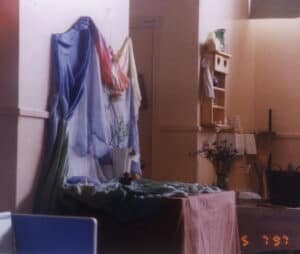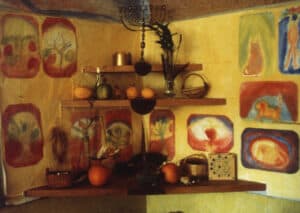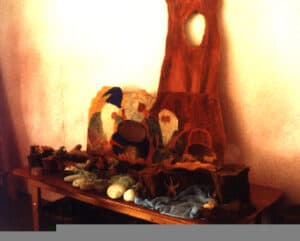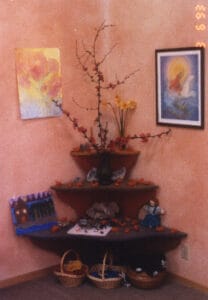by Dan Dugan

Installation by Kindergarten teacher Lauren Rice in Room 1 at Oak Ridge Elementary School, Sacramento CA. Photo by Dan Dugan, May 7, 1997.
“What is the altar in Room One?” a visiting public school teacher challenged parents assembled at Oak Ridge Elementary School on May 7, 1997. They had gathered for a meeting with Superintendent of Schools Jim Sweeney to discuss the school’s “Waldorf Method.” She was referring to a Waldorf school tradition, the “nature table,” and implying that it had a religious significance. Does it?
Every lower-grade Waldorf classroom that I’ve visited has had a nature table. It’s an important part of the Waldorf way. The teachers create the tables with seasonal themes, making artistic arrangements of natural objects such as plants, wood, and rocks, and symbolic objects such as candles, Menorahs, figurines, and polished crystals.

There is not much about nature tables in Waldorf educational literature. The method of creating the tables is passed through oral instruction to the trained Waldorf teachers. Outside observers describe the beauty of these tables, but don’t offer much information about their significance.
Stanford scholar Bruce Uhrmacher describes a second grade nature table:
In the front left corner of the room is a table covered with brown leaves, pumpkins, squash, pine cones, and flowers. Sharing the table with this nature scene are a smooth grey rock, a white candle, and a gold candle snuffer. [Uhrmacher, P. Bruce. Waldorf Schools Marching Quietly Unheard. (Dissertation, Stanford School of Education.) May, 1991, p. 90.]
And a third grade table:
Mr. Gregorian plays a middle C on his flute. The students hum an ascending scale as Mr. Gregorian, palm facing the floor, signals each note. They hold the last note before descending through the scale. The students’ choral hum has an ancient sound, I think, as I look at the nature table in the front of the room. Pine cones, a candle, a wooden gnome, and a scale rest on the red table cloth. Slightly upraised on blue cloth is a large Bible. Above the Bible, hanging on the wall, is a picture of an angel. Next to the angel is the blackboard, and on the other side of the front wall, behind Mr. Gregorian’s desk, is a small round picture of Noah’s Ark. The nature scene and pictures (aesthetic conditions) reflect the third-grade theme of the Old Testament. [Ibid, p. 132]
The WestEd report on the Waldorf charter school in San Diego describes a nature table:
In a kindergarten class that was observed, children sang a song of thanks preceding a snack, but the song was devoid of overt religious words. The same classroom has pink gauze draped over furniture and a table in the back of the room, referred to as a “nature center,” with symmetrically arranged objects from nature and a cloth “Mother Earth” doll. [ WestEd. From Paper to Practice: Challenges Facing a California Charter School: Technical Report. WestEd 12003, May 16, 1996, p. 44]
Washington State University scholar Mary Henry describes the nature tables she saw at the school she studied:
a “Nature Garden” is a feature of the kindergartens and Grades 1, 2, and 3. In the “Nature Garden” natural materials, such as stones, sea shells, twigs, and wood, are arranged on a table covered with a white linen cloth. Hanging above and around the table are filmy muslin drapes in pastel shades, giving the Nature Garden centrality in the classroom. At certain times, a homemade beeswax candle is lit in the “Nature Garden,” and verses celebrating nature are recited. [Henry, Mary E. School Cultures: Universes of Meaning in Private Schools. (Washington State University) Norwood, New Jersey: Ablex Publishing Corp. 1993.]
“Verses celebrating nature” does sound like a religious or reverential activity. The religious nature of this activity is clear when one understands that Anthroposophy is a religion that endows all of nature with spiritual meaning. Ms. Henry’s observation of the “centrality” of the nature table in the lower grades also fits the concept of it being a type of altar at which the students and teacher show their reverence for nature. Some of the behaviors and rituals performed at the Waldorf nature table are much like those performed at an altar in temples and churches. Candles on the tables have both ritual and pedagogical purposes. They sanctify the space by the presence of the “living” flame and they focus the attention of the students.
Focal conditions that create a classroom atmosphere also have pedagogical implications. Specifically, they prepare students and teacher for the upcoming activity by allowing their minds and bodies to absorb the classroom texture–a kind of advance organizer or anticipatory set. However, instead of focusing on the content of the upcoming activity, focal conditions focus students’ attention on the mood or texture of the upcoming activity. Hence, lighting candles appropriately prepares students for verses and storytelling. [Uhrmacher, P. Bruce. Waldorf Schools Marching Quietly Unheard. (Dissertation, Stanford School of Education.) May, 1991, p. 103]
Uhrmacher describes a full-blown morning prayer ceremony. Note the ritual use of bell and candle, and the students’ assumption of the occultist posture of prayer:
Clock time registers 8:50. Miss Bronte [2nd grade teacher] sweeps to the back of the room to turn off the lights and then she says, “Let’s have a golden tone this morning. Who has never done this?” A few students raise their hands. Miss Bronte chooses Ariana to ring the golden tone. With great enthusiasm and anticipation, acting as though she has never done this before, Miss Bronte holds the xylophone for Ariana, who with a flick of the wrist creates the golden tone. The class listens quietly in the darkened room.Next, Miss Bronte strikes a match against the grey rock on the nature table. In unison the class says, “Candle, candle, burning bright, thank you for your loving light.” The students stand and cross their arms in front of their chests and recite a verse by Rodolf Steiner that I am told is the one verse said, with some variation, in every Waldorf classroom between first and fourth grades:
- The sun, with loving light,
- Makes bright for me each day.
- The soul, with spirit power,
- Gives strength unto my limbs.
- In sunlight, shining clear,
- I reverence, O God,
- The strength of humankind
- Which thou so graciously
- Has planted in my soul,
- That I with all my might
- May love to work and learn
- From thee come light and strength
- To thee rise love and thanks.
Students recite the words clearly. Next, with accompanying hand movements, students sing another song. Then they snuff the candle with great attention and ritual… [Uhrmacher, P. Bruce. Waldorf Schools Marching Quietly Unheard. (Dissertation, Stanford School of Education.) May, 1991, pp. 108-109]

The nature table relates to two complementary aspects of the Waldorf way. The first is the role that the teacher plays for the students. In the first three grades, the teacher is supposed to take the role of priest. Having an altar that the priest-figure uses to center attention supports that role.
The students “mood” of reverence is complementary to the teacher’s role as priest. Steiner said:
Veneration and reverence are forces whereby the etheric body grows in the right way. If it was impossible during these years to look up to another person with unbounded reverence, one will have to suffer for the loss throughout the whole of one’s later life. Where reverence is lacking, the living forces of the etheric body are stunted in their growth. [Steiner, Rudolf. Education of the Child in the Light of Anthroposophy. (1909) Trans. George and Mary Adams. London: Rudolf Steiner Press, 1975, p. 31.]
The nature table is at least intended to inspire reverence for nature in the children. This is something everybody can agree with. For Anthroposophists, though, “nature” is much more than the physical world. When it is understood that in Anthroposophy all natural objects are the homes of elemental spirits, the nature table becomes inhabited with living beings. Steiner also taught that natural and sculptured objects attract spirits by their forms and colors:
Steiner wanted us to be very aware that different types of elementary beings penetrate the space and objects around us. Our etheric bodies enter into unconscious relationships with certain of these beings depending upon the nature of our surroundings. “When a sculptured form has a similarity to the etheric body of a supersensible being, then that being is attracted by that form and lives in its vicinity…”The same thing occurs through the qualities of color or paintings in our environment: “The color surrounding us here brings us in touch with beings in our spiritual environment who come to help us in our etheric body in the spiritual activities which we need in order to work up spiritual truths within us…” [Adams, David. “The Goetheanum as White Magic, or Why Is Anthroposophical Architecture So Important?” Journal for Anthroposophy, No. 64, Spring 1997, pp. 22-23.]
Steiner states that childhood training in reverence is preparation for becoming devotees in adulthood:
Spiritual researchers call this basic attitude the path of reverence, of devotion to truth and knowledge. Only those who have acquired this fundamental mood or attitude can become pupils in an esoteric school. Anyone with any experience in this area knows that those who later become students of esoteric knowledge demonstrate this gift for reverence in childhood. Some children look up to those whom they revere with a holy awe. Their profound respect for these people works into the deepest recess of their hearts and forbids any thoughts of criticism or opposition to arise. Such children grow up into young people who enjoy looking up to something that fills them with reverence. Many of these young people become students of esoteric knowledge…We should not fear that such feelings of reverence lead to subservience and slavery; on the contrary, a child’s reverence for others develops into a reverence for truth and knowledge. Experience teaches that we know best how to hold our heads high in freedom if we have learned to feel reverence when it is appropriate–and it is appropriate whenever it flows from the depths of the heart. [Steiner, Rudolf. Knowledge of the Higher Worlds and its Attainment. (1904) Trans. Christopher Bamford. Hudson, NY: Rudolf Steiner Press, 1994, pp. 16-17]
Forbidding “any thoughts of criticism or opposition” sounds like a successful mind control program. And then Steiner goes on to claim that unquestioning devotion leads to freedom! This is a guru trick.

I have found at least one authoritative source for the tradition. In a book which is an essential part of Waldorf teacher training, Steiner said:
[W]hen he [Goethe] was seven he built himself an altar to nature, taking his father’s music stand and placing on it plants from his father’s herbarium and also minerals and crowning it all with a little incense candle that he lit by focusing the beams of the morning sun with a burning-glass; an offering to the great god of nature, a rebellion against everything imposed on him by education. [Steiner, Rudolf. Practical Advice to Teachers: Fourteen lectures given at the foundation of the Waldorf School, Stuttgart, from 21 August to 5 September 1919. (1919) Trans. Johanna Collis. New York: Anthroposophic Press, 1988, p. 113.]
This is pretty explicit, “an altar to nature,” and “an offering to the great god of nature.” And of course, the age of seven is first grade.
